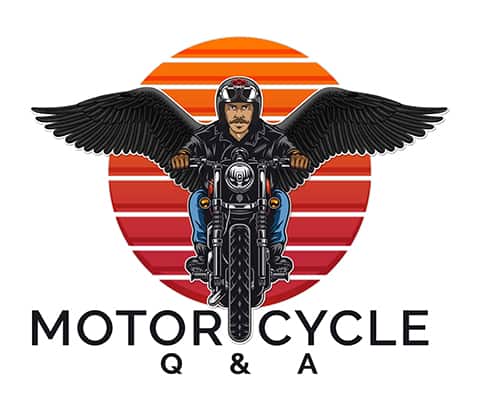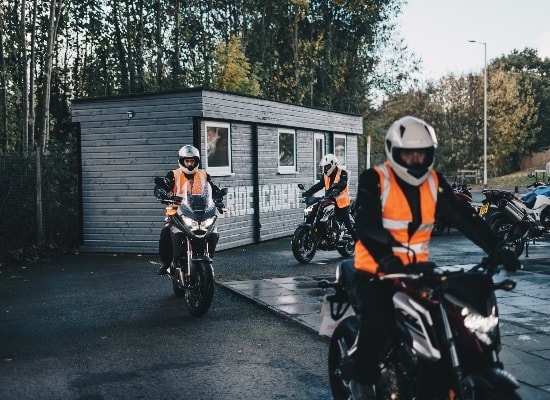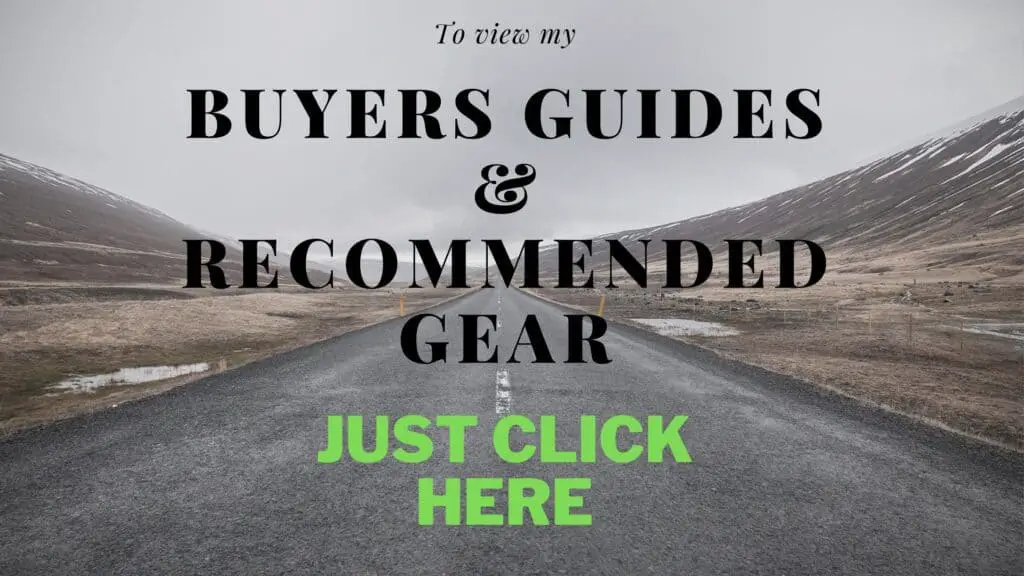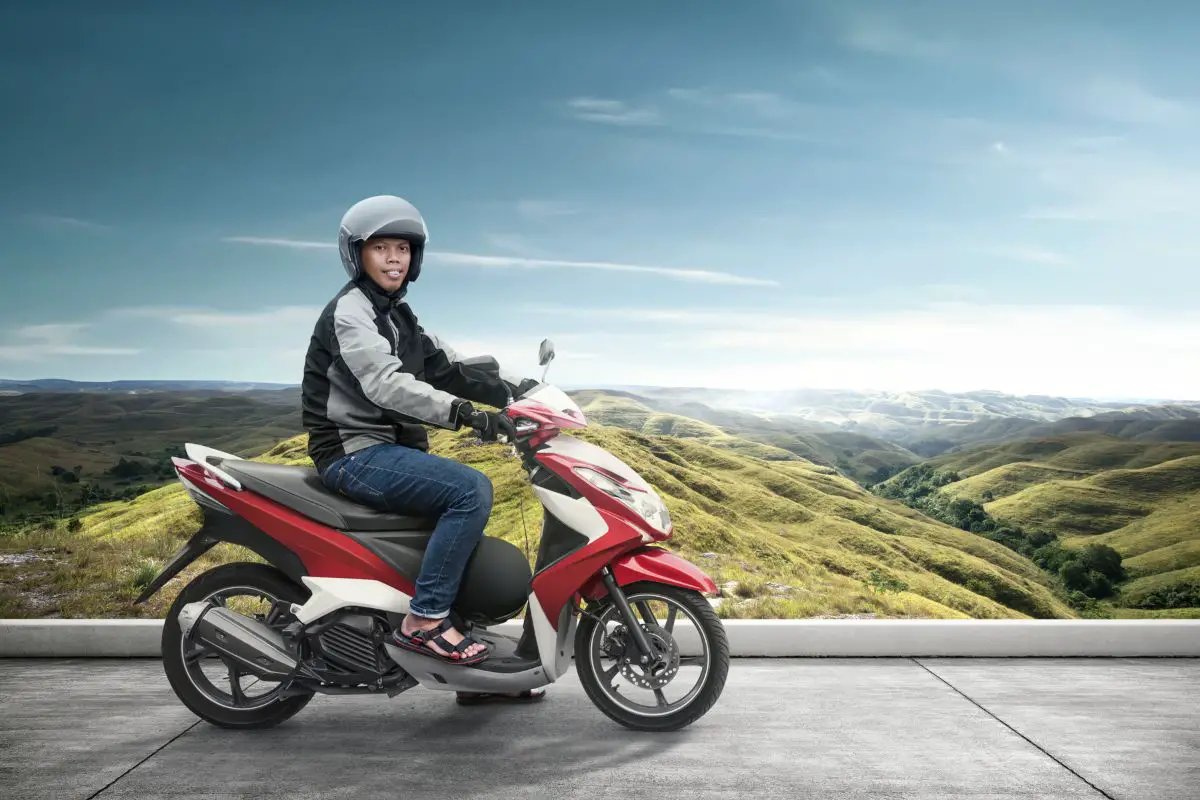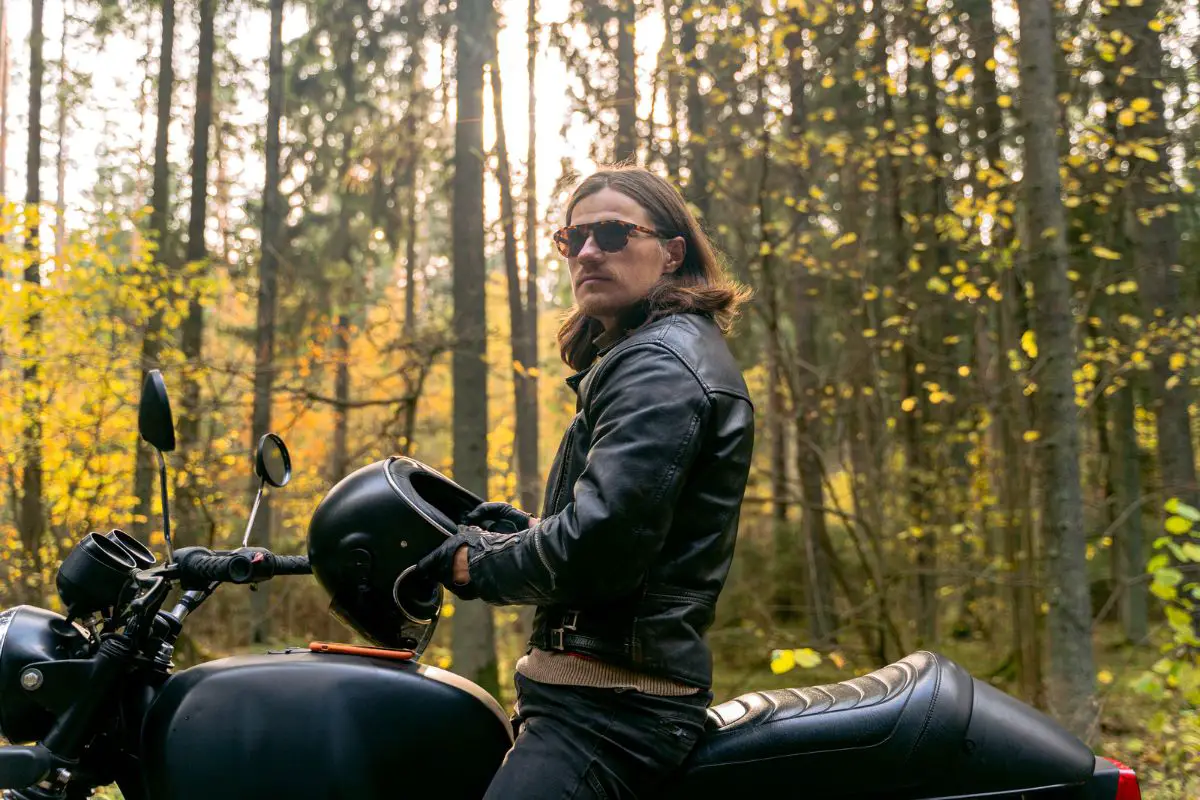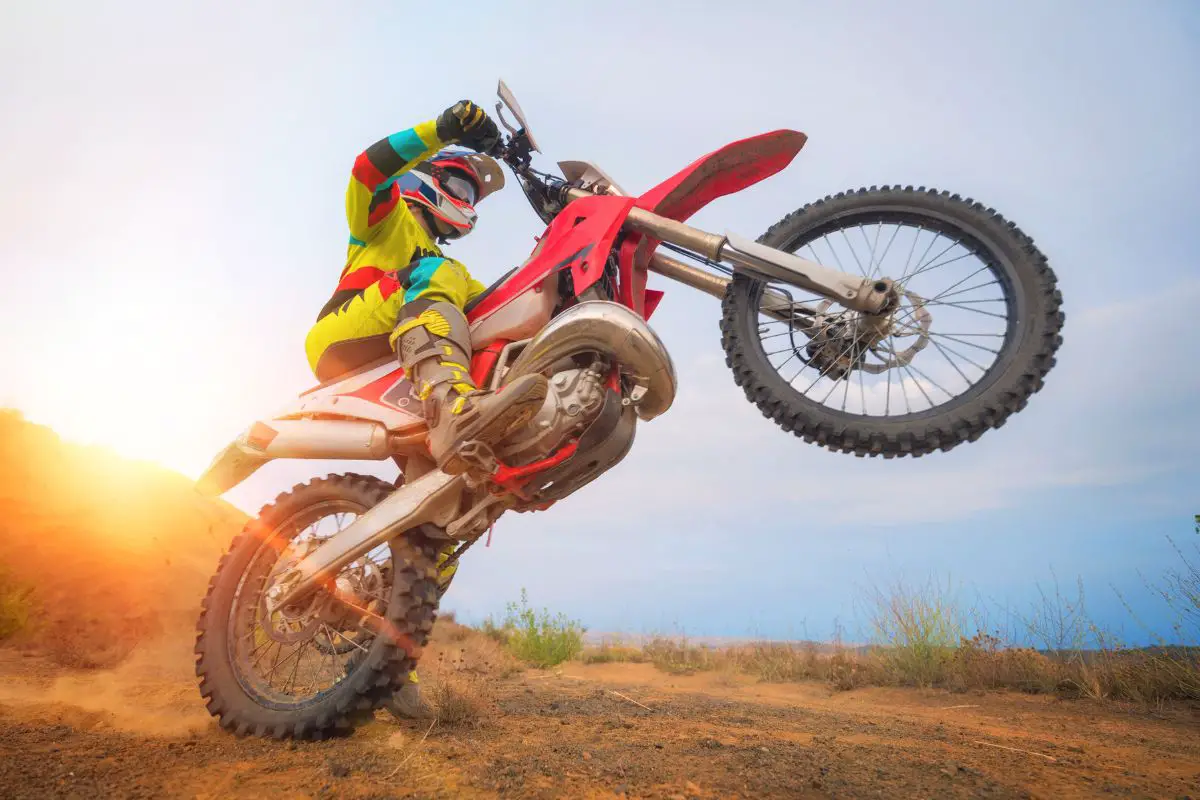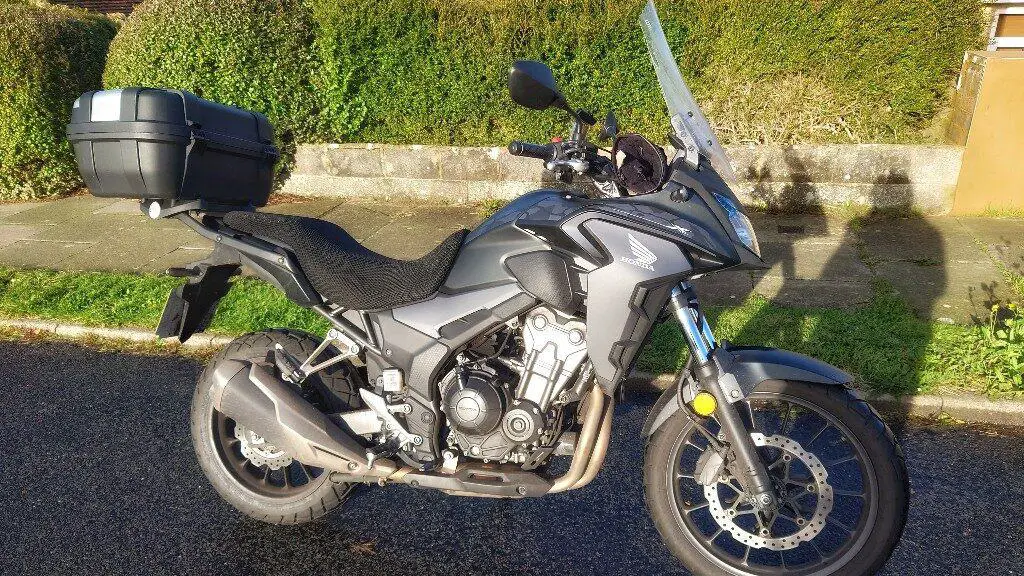
So, is learning to ride a motorcycle hard?
Learning to ride a motorcycle is not hard. After your first few rides, once you have developed muscle memory, the process of learning to ride a motorcycle becomes straightforward. It would be best if you did not take any shortcuts, which can lead to bad habits that can take years to break.
Whether it’s the traffic in your local town or city, or the fact that owning and running a motorcycle is cheaper than a car, or you no longer want to use public transport, many people are considering learning to ride a motorcycle.
How To Ride A Motorcycle. In Easy Steps.
- Sit On The Motorcycle And Learn Where The Controls Are
- Feel The Weight Of The Bike
- With The Engine Off Practice The Front And Rear Brake Movement
- Practice The Clutch Movement Still With The Engine Off
- Start The Engine
- Put The Bike In First Gear And Release The Clutch Slowly
- Practice Changing Gears
- Practice Slowing Down And Stopping
- Learn Where The Controls Are:
It is essential to know where the controls are on a motorcycle as you may not have time to look for the one you want to use at any particular moment. You should be familiar with them so you can keep your eyes on the road and use any of the controls you require at the same time.
Like anything, it is all about practice.
Here are where the controls on a motorcycle are usually located:
- The gear shifter is located by your left foot and is commonly operated as one shift down for first gear then 4 or 5 up to locate the other gears.
- The clutch lever is typically located on the left handlebar, which you pull towards you to disengage the clutch when changing gear.
- The throttle is located on the right handlebar, which you twist towards yourself to accelerate to move the motorcycle forwards.
- The front brake lever is located on the right handlebar in front of the throttle.
- The rear brake lever is located on the right-hand side of the bike by your right foot.
Whilst sitting on the bike, make sure that you can reach the controls comfortably without stretching your arms out too far. It would help if you had a slight bend at your elbows, with all the control switches in easy reach.
2. Feel The Weight Of The Bike:
You can do this whilst sitting on the bike with the engine off. Just hold both sides of the handlebars with your feet planted firmly on the ground. Now rock the motorcycle left to right SLOWLY to get the feel of the bike’s weight.
You don’t have to rock the bike far, just a little bit. You will be able to feel where the weight of the bike is located. Some bikes have their weight located higher up and some low down.
Take into consideration the amount of petrol in the bike’s tank as this will obviously add to the bike’s weight when full.
3. Practice The Front And Rear Brake Movement:
Sitting on the bike with the engine off, practice pulling the front brake lever located on the right-hand side of the handlebar. This should give you an idea of how it will feel when you pull it and allows you to see where your hand’s position will be when operating the lever.
Now lift your right leg and place your foot on the rear brake lever, located on the right-hand side of the bike near your right foot. Press your foot up and down on the lever, which will now be operating the rear brake.
You should be able to feel the resistance of the lever when pressing down on it. When you take your foot off the rear brake lever, it will return to its normal resting position.
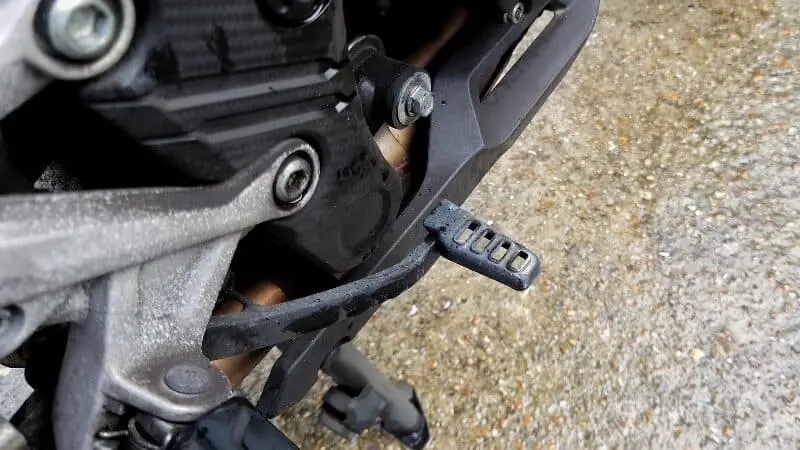
4. Practice The Clutch Movement Still With The Engine Off:
When you pull the clutch lever in (towards you), you may feel some normal resistance.
You pull the clutch lever towards you when you want to change gears. When you pull the clutch lever, you are placing the engine in a neutral position that effectively releases the engine from the transmission. You will now be able to change from the gear you were originally in.
When you want the motorcycle to pull away from a standing position, you pull in the clutch lever and, using your left foot, press downwards on the gear changer. This will put the motorcycle into first gear. You should hear a clunk or feel resistance, indicating that the bike is in gear.
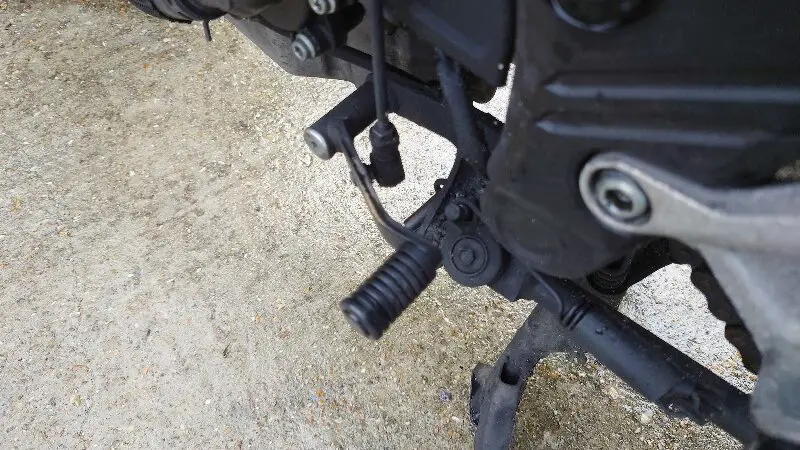
To pull away, you slowly release the clutch with your left hand and twist the throttle gently towards you with your right hand. This action will simultaneously engage the transmission and increase power to the engine, causing the bike to move forwards.
Most motorcycles generally use a configuration of 1 ‘Down’ and 5 ‘Up’ when shifting gears. The normal operating sequence is 1st Gear (one Down), then one up is Neutral, then the rest are upwards gears for 2nd,3rd,4th, and 5th gear.
Each time you wish to change gear, you should disengage the clutch by pulling the clutch lever in and also reduce the throttle at the same time by twisting it away from you. Change the gear using your left foot and gently release the clutch lever twisting the throttle back towards you in a steady motion to keep the engine revs up so the bike will not stall.
The action of the clutch when carrying out this procedure is called ‘feathering the clutch’
5. Start The Engine:
When starting the engine on a motorcycle there are certain factors you will need to be aware of:
- Turn on the ignition and check that all the gauges and lights are operating correctly.
- Check the gear indicator to make sure it is in neutral. There will be a green ‘N’ located on the dash of the bike on many bikes. The easiest way to put the bike into neural is to shift down into the first gear and then shift up one, putting it into neutral.
- Using your right-hand thumb, press the start switch. In this case, it is located under the Hazard Warning Lights switch on the right-hand handlebar.
- Now allow the bike to warm up.
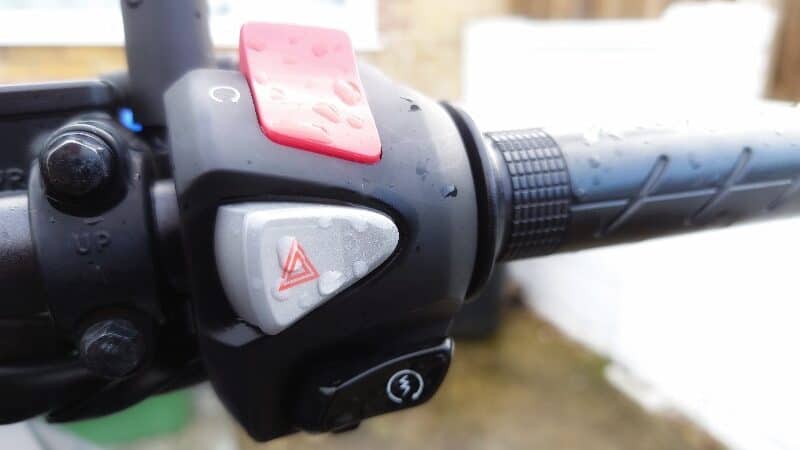
6. Put The Bike In First Gear And Release The Clutch Slowly:
With the engine idling, pull the clutch lever all the way towards the left handlebar and then press down on the gear shifter with your left foot. This will place the motorbike into the first gear.
Now place both your feet firmly on the ground and release the clutch slowly and twist the throttle towards you slowly also.
Keeping your feet firmly on the ground allows the bike to move steadily forward whilst walking with the bike.
Repeat this process until you can put both feet on the motorcycles foot-pegs whilst keeping the bike in a steady, upright position. Practicing this a few times will allow you to get a good feel for the bike and will teach you how to balance the bike correctly whilst allowing it to move forwards using the engine’s power.
7. Practice Changing Gears:
Now you have practiced keeping the motorcycle balanced whilst moving forwards. It’s time to start to ride the bike.
From a standing start with the engine idling, place the bike into first gear and ride forwards as you have been practicing before.
Now put both your feet on the footpegs and press down on the clutch whilst twisting the throttle slowly bach towards you. With your left foot, push the gear shifter up to place the motorcycle into second gear, slowly releasing the clutch and gently twisting the throttle towards you to gain some acceleration.
Ride in a completely straight line repeating the process until you have the bike in third or fourth gear. When you decide that you want to stop the bike, pull in the clutch lever and apply the front and back brake simultaneously until the motorcycle comes to a stop.
Put both feet on the ground once the bike has stopped. Press in the clutch lever, find neutral, turn off the bike at the ignition, and lower the bike stand.
You have now taken your first ride on a motorcycle!
You will need to keep practicing to get used to all the controls and how the bike feels.
8. Practice Slowing Down And Stopping
Now that you have been practicing all the different bikes’ operations, it’s time to put it all together by riding the bike in a straight line and practicing slowing the bike down and coming to a full stop.
When you want to come to a stop or slow down, it’s best to start by engaging the front brake first by pulling the lever located on the right-hand side of the handlebar.
Once the bike starts to slow, you can apply pressure to the rear brake using your right foot.
As you start to slow down you will need to downshift the gears which will help the bike slow as well. This is called ‘engine braking’.
As you are breaking and coming to a stop, you need to make sure that you are not putting back on the throttle. However, since the front brake lever is located in front of the throttle, you should have naturally released the throttle when starting the slowing procedure.
Gradually apply more pressure to the breaks in a smooth motion.
Once you have come to a complete stop, keeping your right hand firmly on the front brake lever, place both feet on the ground to steady the motorcycle.
Now you can practice turning, slowing down, speeding up and changing gears and stopping. The more you practice, the more confidence you will gain.
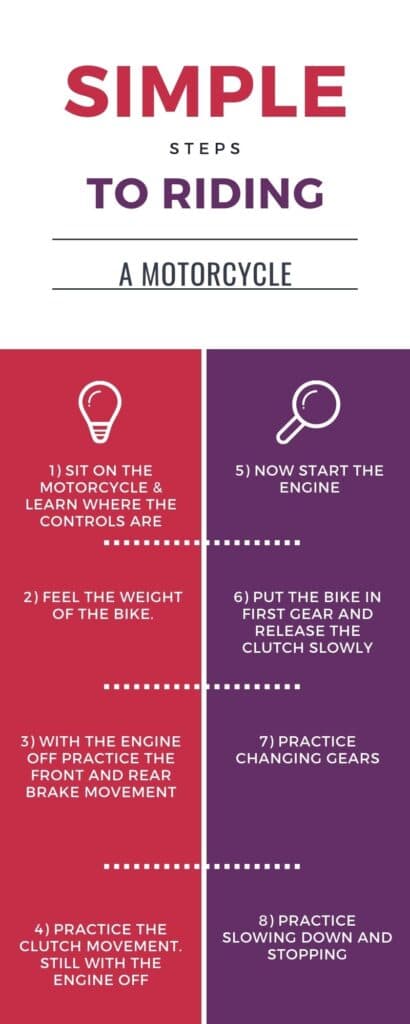
What Are The 3 Stages Of Acquiring A Motorcycle Licence?
Also, if you are a complete beginner you will have to complete a Motorcycle Safety Course if you want to acquire a motorcycle license.
The 3 stages of acquiring your motorcycle license are:
- Get a motorcycle permit.
- Get a motorcycle endorsement on your state’s license.
- Get a motorcycle license.
If you are a complete beginner, you will have to complete a Motorcycle Safety Course if you want to acquire a motorcycle license.
Download Our FREE Guide:
The Motorcycle Safty Course. A Helpful guide
If you want to acquire a motorcycle license, you will be required to take a motorcycle safety course. This course will deal with:
- Basic Vehicle Function
- The Different Types Of Motorcycles
- An Overview Of The Motorcycle Control’s
- The Techniques Of Riding A Motorcycle
- The Laws
- Lots Of Riding Tips Which Will Help You Stay Safe
As well as the course being available at the weekend you may also be able to attend the course on weekday evenings. So if it is easier to attend after work or college, that option is available as well.
These courses are taught by certified instructors, many giving classroom and practical lessons. A large majority supply you with a motorcycle and helmet, so you will learn the skills necessary to ride a motorcycle safely.
Local government department basic training courses may not always be available in your area, but there will usually be non-governmental rider courses available.
These courses are ideal if you are looking to get back on two wheels after a breakaway or want to brush up on your riding skills.
Government statistics have shown that motorcyclists who have taken certified training courses are shown to be less likely to crash.
As well as the basic rider courses, there are also special classes available where experienced riders can enroll.
If you consider taking this course to brush up on your skills, you could qualify for a discount on your motorcycle insurance once completed.
Many local motorcycle dealerships offer these classes, so you could contact a dealer in your local area for more information or visit DMV.org to find dealerships or classes within your local area.
If you are new to riding a motorcycle, it is mandatory to take this course.
Learning to ride a motorcycle is an adventure, and like all adventures, you will need the correct gear to be safe. When it comes to buying your motorcycle gear, it is a very true fact that you get what you pay for.
Cheap motorcycle gear will conform to the minimum safety standards required by the law, whereas more expensive gear will be of a higher quality, which will go above and beyond the minimum standards required.
For example, motorcycle jackets and pants are designed to not only protect your outer body from injury in a crash such as getting a broken arm, leg, or other parts, but higher quality protective clothing can also protect your internal organs as well.
Make sure from the outset you have the correct safety equipment for the riding you will be doing.
What Gear Do I Need To Ride A Motorcycle? A Helpful Guide
- Motorcycle Helmet
- Motorcycle Protective Jacket
- Motorcycle Protective Pants
- Motorcycle Gloves
- Motorcycle Boots
Buying A Motorcycle Helmet. A Helpful Guide:
A motorcycle helmet will protect your head from any injury and, in my view, is the most important part of the gear you will need when riding a motorcycle. It is also the law to wear a helmet in many states.
It should also meet the DOT standard, the U.S Department of Transportation, which will protect your head in an accident. This standard is tested rigorously, and all motorcycle helmets must meet this standard to be used whilst riding on the public roads.
These helmets do not have to be expensive, but the more you pay for a motorcycle helmet, the more protection it will give you as additional features can be built into helmets to improve protection. Please be aware that not all motorcycle helmets are built the same.
In my investigations over the years, I have found the more expensive helmets are much higher quality and offer far more protection than the cheaper ones. In motorcycle helmets, you do get what you pay for!
Where to buy your motorcycle helmet?
You can buy your motorcycle helmet online or in-store. If buying in a store, you will be able to try the helmet on. Make sure it fits snugly, so it protects your head correctly. Hold either side of the helmet with your hands and make sure that your head does not turn inside the helmet.
It may feel rather tight but will loosen off with wear. The main thing is not to buy one that is too loose.
You could choose to purchase your motorcycle helmet online. You will need to measure your own head with a soft tape measure.
When you are on the manufacturer’s website, a section will give you all the information you will need to measure your head correctly to achieve the perfect fit.
You may have to measure your head differently for different brands, so make sure you read each one thoroughly and consult the individual tables to find which size you will require for that particular brand.
I personally feel that full face helmets offer the best protection.
| Adult Size | CM | Hat Size | Inches |
| XX Small | 51 – 52 | 6 3/8 – 6 1/2 | 20 – 20.5 |
| X Small | 53 – 54 | 6 5/8 – 6 3/4 | 20.87 – 21.26 |
| Small | 55 – 56 | 6 7/8 – 7 | 21.65 – 22.05 |
| Medium | 57 – 58 | 7 1/8 – 7 1/4 | 22.44 – 22.83 |
| Large | 59 – 60 | 7 3/8 – 7 1/2 | 23.23 – 23.62 |
| X Large | 61 – 62 | 7 5/8 – 7 3/4 | 24.02 – 24.41 |
| 2X Large | 63 – 64 | 7 7/8 – 8 | 24.80 – 25.20 |
| 3X Large | 65 – 66 | 8 1/8 – 8 1/4 | 25.60 – 26.00 |
| 4X Large | 67 – 68 | 8 3/8 – 8 1/2 | 26.40 – 26.80 |
| 5X Large | 69 – 70 | 8 5/8 – 8 3/4 | 27 – 27.50 |
| Youth Size | CM | Inches |
| Small | 49 – 50 | 19.15 – 19.50 |
| Medium | 51 – 52 | 20.10 – 20.45 |
| Large | 53 – 54 | 20.87 – 21.26 |
An Easy Guide On Buying A Motorcycle Protective Jacket:
When buying a jacket, make sure that it fits well and is comfortable to wear. They are available in leather as well as a mixture of other textile materials.
The jacket should fit snugly but also allowing your arm to move about comfortably. Being uncomfortable in any of your riding gear will cause a distraction to you, and the last thing you want are distractions whilst riding a motorcycle.
Make sure you buy a jacket that is specifically made for use when riding a motorcycle. Don’t rush when purchasing your jacket. Make sure you are happy with the one you purchase as you may be wearing it for a long time if you’re going on a motorcycle trip.
As well as giving protection in a crash, your jacket will also protect you against the sun’s rays, debris being thrown up from the road, the rain, and the wind.
Try to buy a motorcycle jacket with zipped vents that you can open to allow air to flow through when you are feeling hot, and also jackets that have decent rain protection such as Gore-Tex will also keep you more comfortable when out riding.
An Easy Guide On Buying Motorcycle Protective Pants:
As when buying your motorcycle jacket, the pants you buy should fit comfortably and have good protection built-in. Motorcycle pants also come in a range of different qualities, so get the best you can afford as these are protecting your legs, which are also a vital part of your body!
I have often seen other motorcyclists wearing a really nice quality protective jacket and then just a pair of cheap cotton trousers or jeans. Your legs are just as important as the top half of your body but seem to be neglected too often.
You can buy jeans with a mixture of Kevlar, which helps protect the leg, but there is no better way to protect your legs than buying a good quality pair of specifically made motorcycle pants.
When choosing a pair of protective pants, I have found it best to wear my motorcycle boots, which will make a difference in how the pants fit and feel. If trying the pants on with a normal pair of shoes, you may not get the correct length, as motorcycle boots are usually larger and thicker.
Also, it a good idea to sit on a motorcycle when trying out the pants. It will show you where the protection falls on your legs and show you if they are too long or short for you in your riding position. Again your riding pants want to feel snug but also allow for movement of your legs as well!
Buying Motorcycle Gloves, Useful Tips:
The purpose of motorcycle gloves is to protect your hands from getting injured. Whilst riding, your hands could be hit constantly by insects and other flying objects which come from the curb or the road surface. A good pair of gloves will protect your hands.
Waterproof gloves are a must if you will be riding your motorcycle in all weather, and the ability of your gloves to keep your hands warm is also an important factor. If you have cold, damp hands, your concentration level will be reduced, exactly what you don’t want whilst out on the road on a motorcycle.
Here is a YouTube video reviewing some heated gloves.
Gloves are available in leather and other textiles, and you can even buy gloves that warm up if you plug them into the motorcycle battery using an adapter.
When trying motorcycle gloves on, make sure that you have full use of your fingers as don’t forget you will need to operate the motorcycle controls, such as the indicators, and break leaver whilst wearing them.
Buying Protective Motorcycle Boots. What To Look Out For:
Your motorcycle boots perform several different functions, so it is best to buy a quality pair made to perform these jobs correctly, which will last for some years.
As with the rest of motorcycle gear you do get what you pay for.
Motorcycle boots don’t just protect your feet and ankles, and lower leg in crashes. They also help protect your feet against the wind, rain, sun, and any debris that may impact you while riding your motorcycle.
Your motorcycle boots will probably be the only part of your riding gear that you may wear all day, so one of the main considerations should be how comfortable they are.
Speaking from experience, when I go out riding my bike, when I arrive at my destination, I take off my helmet and gloves. I may also remove my jacket, but normally I keep my boots on.
You will have to consider this when purchasing your boots, as it could make a difference to the style you buy. Also, to get the best protection, your boots should cover over the ankle at least and be of high-quality construction at the top, giving you plenty of support.
Your motorcycle boots will not only protect you in a crash but will also protect your feet and ankles if you tip over on the bike at slow speeds.
There have been many incidents of riders injuring their ankles and feet when the bike tips over at a slow speed, and they are unable to hold the bike upright because of the bike’s angle and weight.
Your feet can often get trapped under the bike’s weight, so having a good sturdy quality pair of riding boots is a must for the modern-day motorcyclist.
If you may be riding in all different weather types, you may also want to opt for waterproof boots.
| USA | AUS | CHINA | EUR | JAP | MEX | UK | Inches | CM |
| 5 | 3 | 38 | 36 | 22 | 2.5 | 3 | 8 11/16 | 22 |
| 5.5 | 3.5 | 39 | 37 | 22.5 | 3 | 3.5 | 8 13/16 | 22.5 |
| 6 | 4 | 39.5 | 37.5 | 23 | 3.5 | 4 | 9 | 22.8 |
| 6.5 | 4.5 | 40 | 38 | 23.5 | 4 | 4.5 | 9 1/8 | 23.1 |
| 7 | 5 | 41 | 39 | 24 | 4.5 | 5 | 9 1/4 | 23.5 |
| 7.5 | 5.5 | 41.5 | 39.5 | 24 | 5 | 5.5 | 9 3/8 | 23.8 |
| 8 | 6 | 42 | 40 | 24.5 | 5.5 | 6 | 9 1/2 | 24.1 |
| 8.5 | 6.5 | 43 | 40.5 | 25 | 6 | 6.5 | 9 5/8 | 24.5 |
| 9 | 7 | 43.5 | 41 | 25.5 | 6.5 | 7 | 9 3/4 | 24.8 |
| 9.5 | 7.5 | 44 | 42 | 26 | 7 | 7.5 | 9 7/8 | 25.1 |
| 10 | 8 | 44.5 | 42.5 | 26.5 | 7.5 | 8 | 10 | 25.4 |
| 10.5 | 8.5 | 45 | 42.5 | 27 | 8 | 8.5 | 10 1/8 | 25.7 |
| 11 | 9 | 46 | 43 | 27.5 | 8.5 | 9 | 10 1/4 | 26 |
| 11.5 | 9.5 | 46.5 | 44 | 28 | 9 | 9.5 | 10 1/2 | 26.7 |
| 12 | 10 | 47 | 44.5 | 28.5 | 9.5 | 10 | 10 3/4 | 27.3 |
| 13 | 10.5 | 48.5 | 45 | 29 | 10 | 10.5 | 11 | 27.9 |
| 14 | 11 | 49 | 45.5 | 29.5 | 10.5 | 11 | 11 1/4 | 28.6 |
To measure your foot for a motorcycle boot, you should measure your heel to your big toe.
Please be aware that this is a general chart and should be used as a guide only. A motorcycle boot’s fitment may not be exact and can depend on international conversions and different manufacturer specifications.
